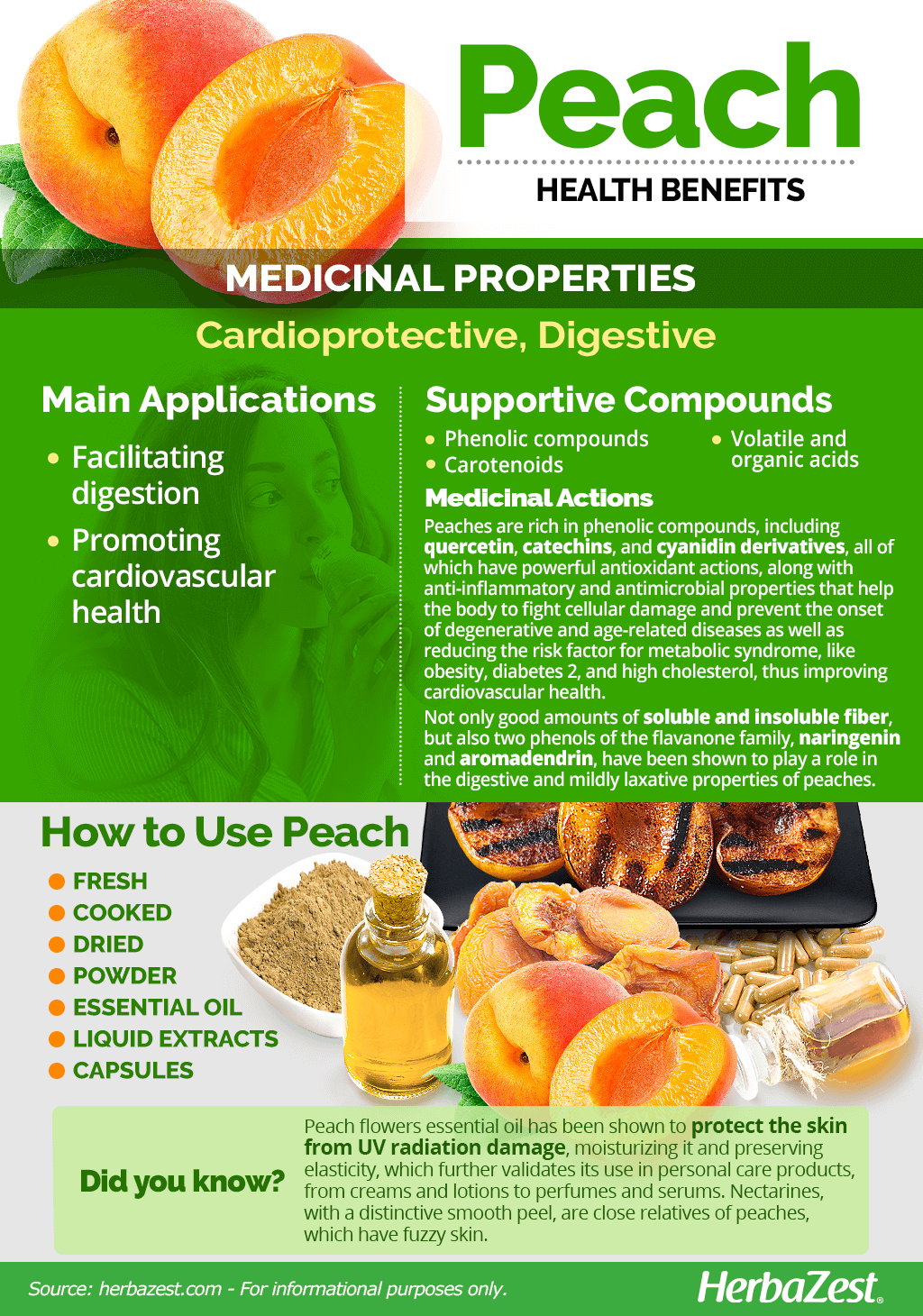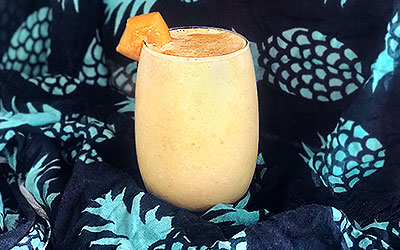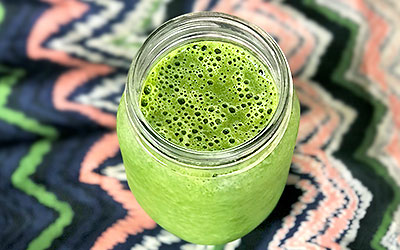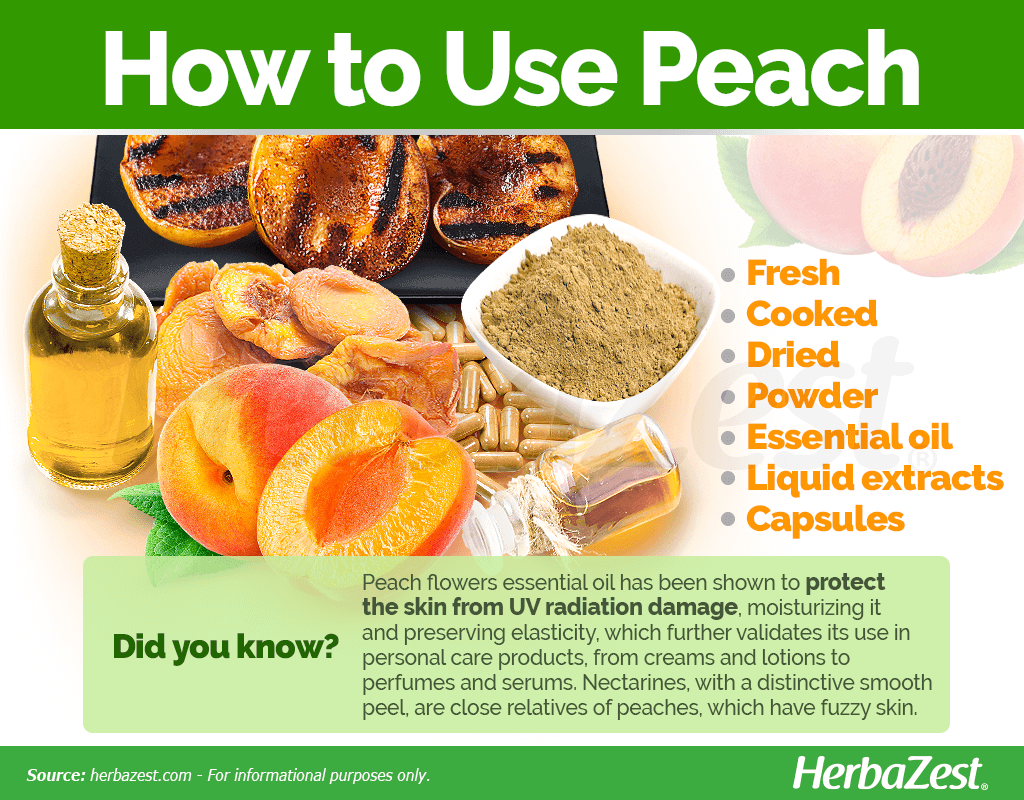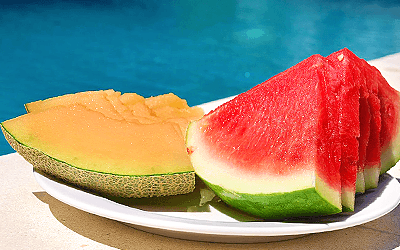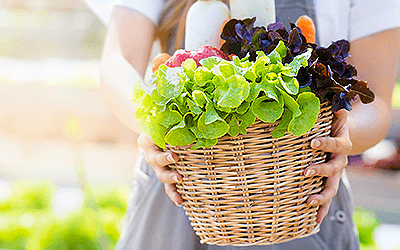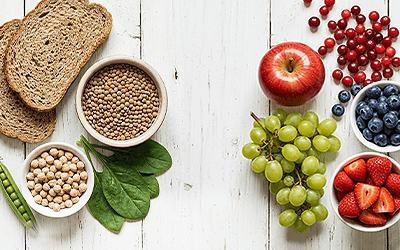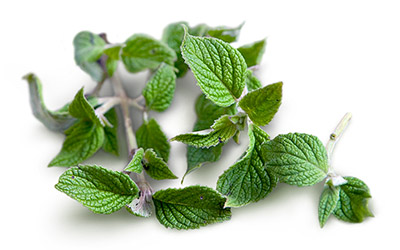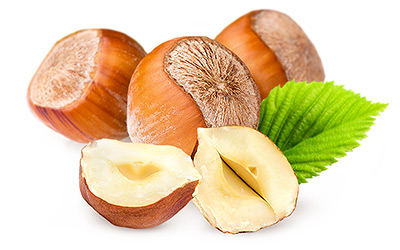Peaches have held great cultural significance in many Asian countries throughout the years, and experts believe peach trees were the first fruit crop to be domesticated in China for culinary and medicinal purposes. Nowadays, peaches are a beloved fruit, consumed around the world in a variety of recipes, but also used in herbalism due its many health benefits.
Peach Medicinal Properties
Health Benefits of Peach
The nutritious properties of peaches make them excellent as an addition to a well-balanced, healthy diet. While the traditional use of peaches for relieving constipation and inflammation has fallen by the wayside, new research is looking into the potential benefits of all the parts of the peach plant.
According to scientific research the main benefits of peaches are:
Facilitating digestion. The dietary fiber and phytocompounds of peaches facilitate the digestive process, which is crucial for proper nutrient absorption and intestinal regularity.1
Promoting cardiovascular health. Peaches contribute to stabilizing blood pressure and preventing the buildup of cholesterol within the arteries, preventing cardiovascular diseases.2
Additionally, preliminary research shown that the active compounds in peaches offer other potential benefits, including:
Treating metabolic diseases. Peaches' active compounds have proven useful for reducing metabolic syndrome risk factors, including obesity, hyperglycemia, and diabetes.3
Protecting the skin. The essential oil from peach flowers has been shown to protect the skin from UV radiation damage, moisturizing it and preserving elasticity.4,5
Traditional Chinese medicine has used the pit of peaches for treating blood stasis, constipation, and inflammation. In the Western world, peaches have been used for gastrointestinal problems, like vomiting, worms, and upset stomach as well as kidney stones.
How It Works
The main active compounds found in peaches are phenols, carotenoids, and volatile and organic acids. The most abundant phenols in peaches are quercetin, catequins, and cyanidin derivatives, all powerful antioxidants, with anti-inflammatory and antimicrobial properties, which help the body to fight the cellular damage caused by free radicals, including degenerative and age-related diseases.6
Not only the fiber of the peach fruit, eaten with peel, helps promote smooth digestion, but peach blossoms' phenolic compounds (mainly naringenin and aromadendrin) may also play a role in the treatment of constipation.1
The extracts of peach have proven effective for reducing abdominal fat, triglycerides, and total cholesterol, helping treat and prevent metabolic disorders, including obesity and heart disease.7
Eating peaches as part of a healthy diet is great for protecting the brain, heart, nervous system, and skin from a number of diseases.
Other herbs with digestive properties are arracacha, dates, kiwi, prunes, and sweet potato, whereas avocado, green tea, lucuma, quinoa, and stevia can help reduce the risk factors for metabolic syndrome, including diabetes, obesity, hypertension and high cholesterol.
Peach Side Effects
Within the normal range of consumption as a food, peaches are excellent for health and pose no threats. However, peaches are among the foods that can cause gas (because of their carbohydrate content), so they need to be consumed wisely.
Some people may react to an allergen found in peaches, Pru p 7, also known as peamaclein, and should avoid eating this fruit, especially fresh.8 Symptoms of peach allergy generally appear within 5-15 min after consuming the raw stone fruit, and can include itching and inflammation of mouth and throat. More severe reactions are urticaria, abdominal pain, vomiting and anaphylaxis. Canned or candied peaches are usually better tolerated because most allergens break down during processing.
Cautions
Due to their amigdalyn content, which is transformed into hydrogen cyanide after ingestion, peach pits are known to be potentially toxic and can be harmful if not administered properly. Peach pit preparations should only be consumed under medical supervision.
- Medicinal action Cardioprotective, Digestive
- Key constituents Phenolic compounds, carotenoids, volatile and organic acids
- Ways to use Capsules, Hot infusions/tisanes, Liquid extracts, Food, Juiced, Powder, Essential oil, Dried
- Medicinal rating (3) Reasonably useful plant
- Safety ranking Safe
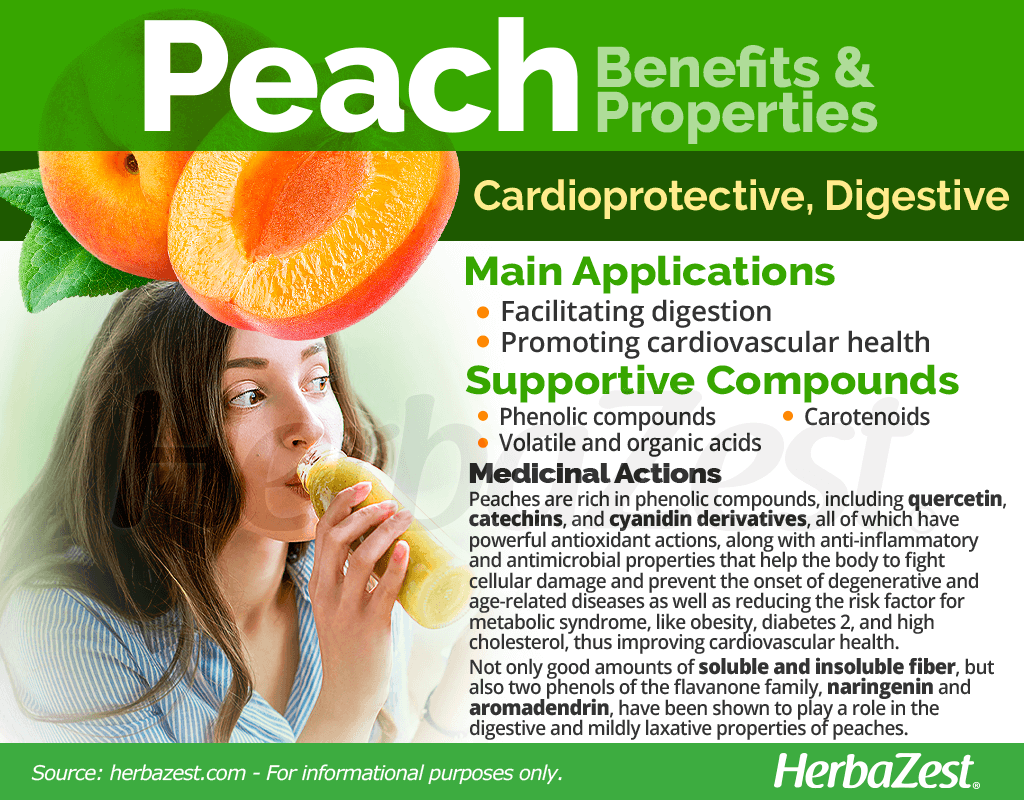
Peach Nutrition
Although peaches - as well as their close relatives, nectarines - are not considered among the top antioxidant fruits, they contain adequate amounts of essential nutrients, enough to be beneficial for overall health.
Eating peaches with peel provides a good deal of dietary fiber, both soluble and insoluble, which is necessary for optimal digestive function and intestinal motility.
While the amount of minerals in peaches is not significant, the presence of potassium, copper, and manganese contributes to electrolyte balance, proper nervous fuction, and bone health.
Peaches also contribute to a healthy diet with good quantities of vitamin C (ascorbic acid), necessary for iron absorption, collagen production, and immunity. Additionally, they provide B-group vitamins, mainly B2 (riboflavin) and B6 (pyridoxine), which are needed for the metabolism of fats and other bodily functions. The provitamin A content of peaches (from carotenes) may not be significant but includes lutein and zeaxanthin, two dietary carotenoids that promote healthy vision and contribute to the antioxidant actions of these delicious fruits.
100 grams of peaches with peel provide 52 calories, 5%DV of carbohydrates and 10%DV of dietary fiber.
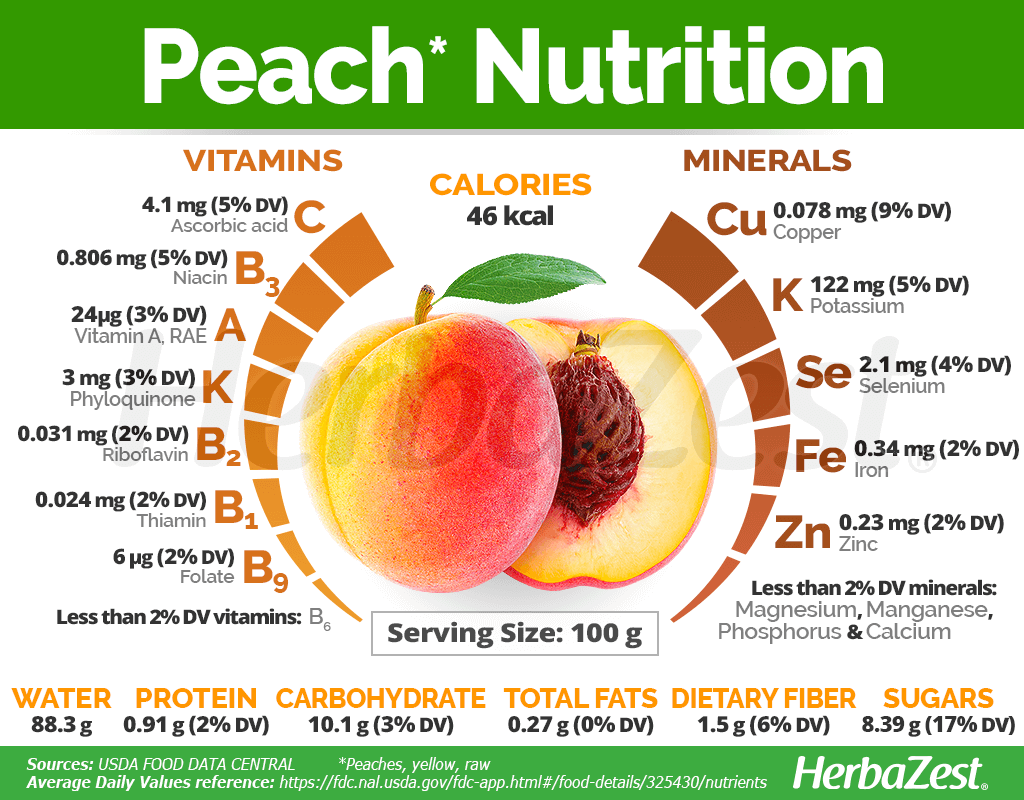
How to Consume Peach
Like many fruits, peaches are incredibly versatile in the kitchen; they can be used fresh, canned, or frozen, and they may be cooked, baked, dried, and more.
Natural Forms
Fresh. Fresh, ripen peach fruits are better eaten with their skin in order to reap their digestive benefits and make the most of their nutrients.
Cooked. The firm, fleshy interior of peaches is ideal for culinary uses. Peaches make great pies, jams, cobblers, cakes, preserves, and more, lending all their digestive fiber and nutritional value.
Dried. With a longer shelf-life, dried peaches preserve their flavor and beneficial compounds and can be eaten as a healthy snack or added to a variety of recipes.
Powder. Peach powder is popularly consumed as an antioxidant supplement for metabolic health since this fruit is thought to aid weight loss as well as cholesterol and blood pressure control. In this form, peaches can be added to juices and shakes.
Herbal Remedies & Supplements
Essential oil. Obtained from the pit, or kernel, the moisturizing and regenerative properties of this essential oil are used topically to reduce the appearance of wrinkles, dark spots, puffiness, and dark circles under the eyes.
Liquid extract. Rich in antioxidant compounds, including vitamins C and E, peach liquid extract not only speeds up wound healing but also prevents early aging-related changes on the skin.
Capsules. Peach leaf capsules are not that common but their anti-inflammatory properties are used for treating gastrointestinal problems, like irritation and vomiting. Peach leaves have been traditionally consumed to relieve diarrhea and dyspepsia.
- Edible parts Fruit
- Edible uses Flavoring, Coloring
- Taste Sweet
Growing
Peach trees grow up to 15 - 25 feet (5 - 8 m) tall, and their canopy is usually wider than it is high. Leaves are dark green and about 3 - 6 inches (8 - 15 cm) long. Peach trees flower in spring, right before the new leaves unfurl, flaunting colors of white to pink to red, and fruits mature by mid- to late summer. In the fall, the leaves turn a bright, warm yellow color before falling.
Growing Guidelines
Peaches prefer temperate climates and don't do well in cold weather. Temperatures between -4 to -13°F (-20 to -25°C) kill the flowers, and temperatures below -22°F (-30°C) damage the wood. Thanks to hybridization, peach growing has been extended to subtropical areas, with low chilling requirements.
They grow best in well-drained, moist, slightly acidic to neutral soils.
Peach trees need plenty of water during periods of sunny, dry weather. However, avoid excessive or irregular watering when fruit is ripening to avoid the skin splitting.
They thrive in full sun.
Peaches are best fan-trained against a south or southwest facing wall or fence.
Bare root peaches are best planted from November to March, at a distance of six to eight inches (15 - 20 cm) from the wall, and angled slightly towards it.
If growing several peach trees, spacing should be 12 - 15 feet (4 - 5 m) apart.
They require thinning when fruit appears in order to achieve maximum growth. With peaches, aim to have a fruit every six inches (15 cm).
Fruit is ready for harvesting after it has gained its full color and the flesh near the stalk feels soft.
The flowers of peaches appear very early on in the year, so protection from frost may be necessary to prevent the potential crop from being harmed.
The peach tree is largely self-pollinating (70 - 85%), so propagation by seed often provides less variability than in cross-pollinated species.
Peach tree fruit appears almost entirely on shoots made in the previous season, so pruning is necessary to replace fruited wood with new, young wood.
Peach trees may live anywhere from 8 - 20 years, depending on location and dedication - a relatively short span.
They are extremely susceptible to disease and pests, especially the pox virus.
- Life cycle Perennial
- Harvested parts Flowers, Leaves, Fruit, Bark
- Light requirements Full sun
- Soil Loamy sand, Well-drained
- Soil pH 5.6 – 6.0 (Moderately acidic), 6.1 – 6.5 (Slightly acidic), 6.6 – 7.3 (Neutral)
- Growing habitat Temperate climates
- Pre-germination seed treatment Stratification
- Plant spacing average 0.15 m (0.49 ft)
- Potential diseases Pox virus
Additional Information
Plant Biology
Peaches are deciduous trees, akin to other species that are collectively known as "pitted fruits," "stone fruits," or "drupes," like cherries or plums, due to their large center pits. In northern regions, peach tree has high chilling requirements, long internodes, single flower buds, upright branching, large flat leaves, and largely cling- or semi-clingstone fruit. In southern areas, characterized by mild winters, peach trees have more lateral branching, with less chilling requirements. Peach trees flower in spring, right before the new leaves unfurl, flaunting colors of white to pink to red,and fruits mature by mid- to late summer. In the fall, the leaves turn bright, warm yellow before falling.
Classification
Peach (Prunus persica) belongs to the large Rosaceae family, along with over 2,800 species spread out across 95 genera, including apple (Malus domestica), pear (Pyrus communis), agrimony (Agrimonia eupatoria), and blackberry (Rubus fruticosus).
The Prunus genus comprises 63 species, notably including peach (Prunus persica), apricot (Prunus armeniaca), cherry (Prunus spp.), almond (Prunus dulcis), and plum (Prunus domestica).
Varieties and Subspecies of Peach
Hailing from China, there are now thousands of peach cultivars in the world. In the United States, all commercialized types of peaches fall into two categories: freestones, or clingstones. Freestone peaches are generally eaten fresh, while clingstones are more firm and used almost exclusively for canning.
When it comes to colors and shapes, peaches can be categorized into:
Yellow peaches. These are the most common peaches around the world. Yellow peaches have a sweet and slightly acidic taste, and they can present light yellow to orange yellow hues, sometimes mixed with red.
White peaches. With a light-colored pink skin and a pale yellow pulp, white peaches have a flavor similar to yellow peaches, but are slightly sweeter.
Donut peaches. This is a heirloom variety of peaches. Donut peaches are flatter and puffier than other peach varieties, hence the moniker. They have a yellow and reddish skin, with a sweet, white pulp, and their season goes from July to August.
Nectarines. As members of the same species, nectarines (Prunus persica var. nucipersica, or var. nectarina) can be clingstone or freestone, but the main difference between them and other types of peaches is their silky, smooth skin, free of fuzz. With a firm pulp and a honey-like, sweet flavor, nectarines are very popular for cooking.
Historical Information
The cultivation of peaches can be traced as far back as the 10th century BCE, according to ancient Chinese records, and experts believe peach trees were the first fruit crop to be domesticated in China, and they have held great cultural significance in many Asian countries throughout the years; they were traditionally regarded as "the fruit of kings and emperors" in the region.
Eventually, peaches made their way to Persia along the Silk Road, and then on to Europe after Alexander the Great conquered Persia. In the 16th and 17th centuries, Europeans introduced peaches to South and North America, where Native Americans and settlers facilitated its spread across the continent.
Popular Beliefs
Peaches and peach blossoms are an important thread in the tapestry of Chinese history. Peach wood was used for arrows, to guard gates and doors, for exorcism wands, and more. All parts of the peach tree (wood, blossoms, fruit, and pit) have been traditionally associated with springtime, fertility, and especially long life.
Economic Data
Rosaceae, the family to which peaches belong, is the third most economically important plant family in temperate areas of the world. Peach, specifically, is cultivated in more significant quantities than most other tree fruits. They are grown in over 70 countries across the globe, and in 2012, the world produced approximately 21 million tons (19 million tonnes) of peaches and nectarines. China is the largest producer of peaches, followed by the United States, where peaches are grown in about two-thirds of all the states.
Other Uses
Landscaping. Due to its dark, rich foliage and striking display of pink or white flowers, the peach tree is a popular ornamental.
Fuel. Peach wood has been long used as fuel for barbecues and fireplaces.
Carpentry. The hardy wood of the peach tree is great base material for furniture.
Cosmetics and aromatherapy. Peach seeds yield a fixed oil, similar to almond oil, that is often used in the formulation of skincare products and perfumes as well as in candles.
Dye. The pigment produced by peach leaves and pulp has many industrial applications.
- Other uses Cosmetics, Dye, Fuel, Furniture/carpentry, Perfume, Soapmaking
Sources
- Australian Government, Victoria State Government, Peach
- Government of California, California Department of Public Health, Harvest of the Month, Peach
- Journal of Cosmetic Science, The extract of the flowers of Prunus persica, a new cosmetic ingredient, protects against solar ultraviolet-induced skin damage in vivo, 2002
- Molecular Medicine Reports, Variation in minerals, phenolics and antioxidant activity of peel and pulp of different varieties of peach (Prunus persica L.) fruit from Pakistan, 2012.
- National Institutes of Health, YOUR GUIDE TO Lowering Your Blood Pressure With DASH | Weight-loss and Nutrition Myths | Gas in the Digestive Tract
- Nutrients, Fruits for Prevention and Treatment of Cardiovascular Diseases, 2017
- The Origins of Fruits, Fruit Growing, and Fruit Breeding, 2005
- The University of Manchester, Allergy information for: Peach (Prunus persica)
- Thomas Jefferson Foundation, Peaches
- University of Florida, Prunus persica: Peach
- University of Michigan Health, Prunus persica
- USDA Food Data Central, Peaches, yellow, raw
- Journal of Medicinal Food, Antioxidant potential of peels and fleshes of peaches from different cultivars, 2009
- Royal Horticultural Society, Grow your Own, Peaches
Footnotes:
- Evidence Based Complementary and Alternative Medicine. (2023). Molecular Mechanism of the Therapeutic Effect of Peach Blossom against Constipation: An Exploratory Study Based on Network Pharmacology Analysis and Molecular Docking Verification. Retrieved October 11, 2023, from: https://www.ncbi.nlm.nih.gov/pmc/articles/PMC10101742/
- Food Chemistry. (2013). Peach (Prunus persica) extract inhibits angiotensin II-induced signal transduction in vascular smooth muscle cells. Retrieved October 10, 2023, from: https://www.sciencedirect.com/science/article/abs/pii/S0308814613001787
- Food Chemistry: X. (2023). Quantitative and qualitative determination of carotenoids and polyphenolics compounds in selected cultivars of Prunus persica L. and their ability to in vitro inhibit lipoxygenase, cholinoesterase, α-amylase, α-glucosidase and pancreatic lipase. Retrieved October 10, 2023, from: https://www.sciencedirect.com/science/article/pii/S2590157523000615
- Mutation Research/Genetic Toxicology and Environmental Mutagenesis. (2001). Protection against ultraviolet B- and C-induced DNA damage and skin carcinogenesis by the flowers of Prunus persica extract. Retrieved October 10, 2023, from: https://www.sciencedirect.com/science/article/abs/pii/S1383571801002182
- Antioxidants (Basel). (2021). A Unique Acylated Flavonol Glycoside from Prunus persica (L.) var. Florida Prince: A New Solid Lipid Nanoparticle Cosmeceutical Formulation for Skincare. Retrieved October 10, 2023, from: https://www.ncbi.nlm.nih.gov/pmc/articles/PMC7998748/
- Food Reviews International. (2022). Peach (Prunus Persica): Phytochemicals and Health Benefits. Retrieved October 10, 2023, from: https://www.tandfonline.com/doi/abs/10.1080/87559129.2020.1837861
- Nutrients. (2020). Anti-Obesity Effects of a Prunus persica and Nelumbo nucifera Mixture in Mice Fed a High-Fat Diet. Retrieved October 11, 2023, from: https://www.ncbi.nlm.nih.gov/pmc/articles/PMC7694277/
- Nutrients. (2022).Phenotypes and Endotypes of Peach Allergy: What Is New?. Retrieved October 12, 2023, from: https://www.ncbi.nlm.nih.gov/pmc/articles/PMC8912752/
